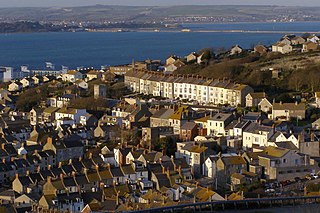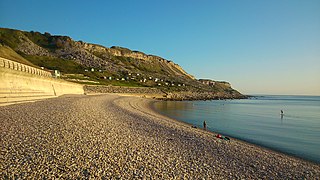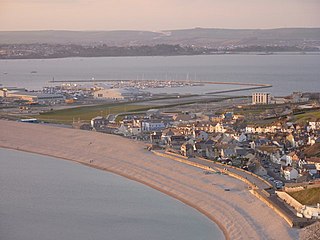
Portland Bill is a narrow promontory at the southern end of the Isle of Portland, and the southernmost point of Dorset, England. One of Portland's most popular destinations is Portland Bill Lighthouse. Portland's coast has been notorious for the number of shipwrecked vessels over the centuries. The dangerous coastline features shallow reefs and the Shambles sandbank, made more hazardous due to the strong Portland tidal race.

Fortuneswell is a village in Underhill on the Isle of Portland, in Dorset, England. It lies on steeply sloping land on the northern edge of the island, known as Underhill, where Chesil Beach connects the island to the mainland. Adjoining Fortuneswell are Chiswell to the west and Castletown to the north. Fortuneswell occupies the steeper land above sea level, whereas Chiswell and Castletown occupy flat land close to sea level, next to Chesil Beach and Portland Harbour respectively. Fortuneswell has a main shopping street, and along with Easton, is the main hub of the island's activities.

Easton is a village on the Isle of Portland in Dorset, England. The village is situated at Tophill, within the centre of the island. As with the rest of Portland's villages and settlements, Easton, including the settlements Reforne and Straits, has been designated as a conservation area, as it is a place of special architectural and historic interest. Easton, Wakeham and Reforne were designated pre-1974.

Wakeham is a hamlet near the village of Easton, in Tophill on the Isle of Portland in Dorset, England. It is situated between the Straits part of Easton, and Pennsylvania Castle. As with the rest of Portland's villages and settlements, Wakeham has been designated as a conservation area, as it is a place of special architectural and historic interest. Easton, Wakeham and Reforne were designated pre-1974. The hamlet features a distinctively wide road running through it, once built to allow space for horse-drawn carts transporting stone by road. Many of Wakeham's older buildings of the 17th and 18th century survive.

Chesil Cove is a curved steep bank forming the south-east end of 29-kilometre (18 mi) Chesil Beach in Dorset, England. It is thus part of one of three large shingle structures in Britain, extending from West Bay to the Isle of Portland, the latter acting more firmly as a great barrier (groyne) which stops tidal action from washing the beach away and leads to the high depositions by wind and tide action forming the grand curved bank of this "cove". The "cove", bill and much of Chesil Beach give shelter from the prevailing winds and waves for much of Weymouth Bay, the town of Weymouth and the village of Chiswell. It forms part of the Jurassic Coast.

Southwell is a small coastal village in Tophill on the Isle of Portland, Dorset. As Portland and Dorset's southernmost village, it lies between Portland Bill and the villages of Easton and Weston. Though close to the Bill, the village is sheltered by hills on three sides. It is the only village on Portland not to be designated a conservation area.

Chiswell, sometimes, is a small village at the southern end of Chesil Beach, in Underhill, on the Isle of Portland in Dorset. It is the oldest settlement on the island, having formerly been known as Chesilton. The small bay at Chiswell is called Chesil Cove, and the beach promenade and sea wall which form Chiswell's coastal defences are a prominent feature.

There are 100 Grade I listed buildings in Bristol, England according to Bristol City Council. The register includes many structures which for convenience are grouped together in the list below.

The Old Higher Lighthouse is a disused 19th century lighthouse on the Isle of Portland, Dorset, southern England. It is located at Branscombe Hill on the west side of Portland, overlooking Portland Bill. The lighthouse is Grade II Listed.

St. Peter's Church is a former Church of England church in The Grove, on the Isle of Portland, Dorset. Designed by Major-General Sir Edmund Du Cane, the church was built in 1870-72 and is now a Grade II* Listed building. The gate piers and boundary walls to the north and west of the church are also Grade II Listed, along with the church's vicarage. St. Peter's Church is included on English Heritage's "Heritage at Risk" register.

St George's Centre is a former school, built in the 19th century, and now a community information and activity centre on the Isle of Portland, Dorset, England. It is located in the area of Reforne, near the village of Easton. Both the centre and its community hall, which was formerly the school assembly hall, have been a Grade II listed since 1978.

The Cove House Inn is an 18th-century public house on the Isle of Portland, Dorset, England. It is situated within the village of Chiswell, and alongside Chesil Beach on the esplanade. The Cove House Inn remains one of Portland's most popular pubs, and has been reputed to be one of the best inns for panoramic views in the area. The pub has been a Grade II Listed Building since May 1993.

The United Reformed Church is a former United Reformed Church in Chiswell, on the Isle of Portland, Dorset, England. It was founded in 1825 and closed in 2009.

St. John's Church is an Anglican Church of England church in Fortuneswell, on the Isle of Portland, Dorset. It was built between 1838–40 and has been a Listed Grade II building since January 1951. The churchyard walls, gate piers, railings, and steps of St. John's Church, dating from 1839–40, became Grade II Listed in September 1978. At this same time, two headstone monuments, about 5 metres north east from the west tower of the church became Grade II Listed.

Underhill Methodist Church is a Methodist Church, opened in 1899, located in Fortuneswell, on the Isle of Portland, Dorset. It was built between 1898–1899, replacing a 1793 chapel built by Robert Carr Brackenbury, the founder of Methodism on Portland. The church remains active to date, as part of the Portland Methodist Circuit, alongside Easton Methodist Church.

Easton Methodist Church is a Methodist Church in Easton, on the Isle of Portland, Dorset, which was built in 1906–07. The church, along with its former manse and boundary walls, has been a Grade II* Listed since May 1993. Its church hall was formerly a Wesleyan school, dated 1878 on the porch. The school, with the boundary wall, was designated Grade II in May 1993. The church remains active to date, as part of the Portland Methodist Circuit – which involves two churches; Underhill Methodist Church and Easton Methodist Church.

Southwell Methodist Chapel is a former Methodist chapel at Southwell, on the Isle of Portland, Dorset, England. The chapel was built in 1849 between terraced cottages on the east side of the road leading from Southwell to Portland Bill. It closed in 1997 and is now a private residence. It has been Grade II Listed since May 1993.

Victoria Square is a public square on the Isle of Portland, Dorset, England. Developed in the 19th century, it is situated at the entrance to Portland, close to Chesil Beach, Osprey Quay, and the small fishing village of Chiswell.


















